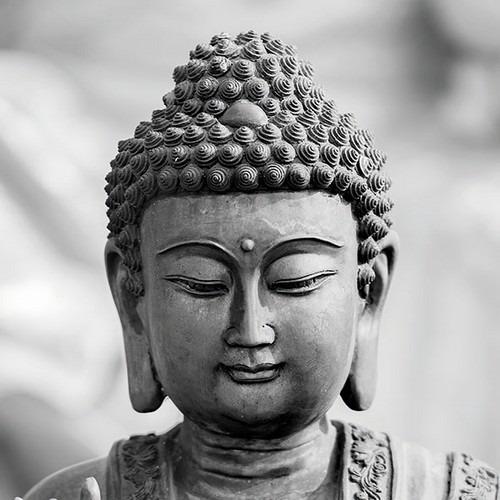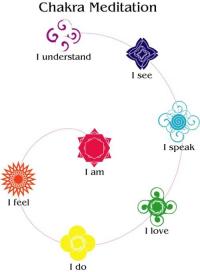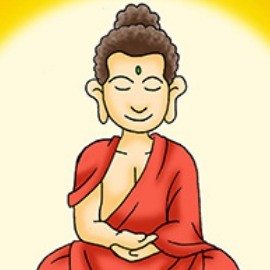THE RIGHT MEDITATION

The final path of the way of the Buddhas is meditation, the practice of all the Buddhas and patriarchs. While meditation is the most straight forward and simple of the eight paths, meditation is also the most removed from our everyday life. We employ world view, intentions, speech, work at a vocation, choose courses of moral action, and apply some mindfulness in our everyday life whether we are on a spiritual path or not. We do not, however, meditate as a natural part of our normal existence. This is why meditation carries with it an exotic quality in the minds of most non-practitioners. Combined with this are all the fantastic references to magical powers that can be attained through the practice of meditation. One assumes then that since enlightenment itself is the ultimate result of meditation, enlightenment must be some sort of magical state of being, as well.
The truth of reality of meditation is quite the opposite, as any Zen student who has spent years crushing kopak with his or her buttocks can attest. Sitting quietly, confronting the vast panorama of our own ignorance until it exhausts itself, is anything but magical. The best description of good meditation is that it is nothing special at all, just meditation. Right meditation is so boring that boring itself turns in on itself and vanishes. When boredom and excitement both disappear then enlightenment arrives.
Enlightenment itself is boring as long as it is enlightenment. Meditation must become part of that everyday life like eating, sleeping, walking, etc., or else it is not right meditation. Like all the other paths it is an activity which is intrinsic to the life of the practitioner. We do not meditate to attain enlightenment or improve ourselves. We meditate because it is our path to meditate. In other words, the urge to meditate must spring out of the other seven paths beginning with right view through right mindfulness. If it does not follow from the continuous application of the principles of the preceding paths, then it cannot be right meditation.
It is not just the technique of meditation that determines whether meditation is right or not, but the reality of the meditation as part of the ongoing experience of enlightened life that is the eight fold path. There are numerous types of meditation which are traditional and effective provided they are consistent with the practitioners total practice. That practice cannot be separated from life itself. The beginning of meditation is found in the path of right views which directs our attention to the reality which is hidden from us by our ignorance and which can be revealed through meditation. If we do not fully comprehend the importance of understanding the nature of spiritual life, we will not be able to master meditation properly.
Just as was the case with all the other paths, meditation interpenetrates with all aspects of our spiritual life. They in turn are always effecting our meditation efforts. What I am saying, is that two people can meditate using identical techniques, and one can obtain results that reinforce their spiritual life, while the other ends up in a mental hospital. It was not the meditation itself that produced either result, but the life of the individual as it reacted to, and was effected by, the individual's meditation efforts. It is not necessarily a flow in the way the meditation technique is applied (although the misapplication of meditation is dangerous) which produces disaster, but a life inconsistent with the energy of meditation pouring that energy into itself.
Herein lies the danger in the notion of meditation as a cure all. Right meditation is only "Right", that is effective spiritually, if it is consistent with the rest of our spiritual efforts. Meditation does not cure life problems, it energizes the mind to either deal with those problems or inflate them by giving more power to the ego. This is the reason sometimes powerful meditation masters fall in to grievous states. When life is inconsistent with the eight fold path, meditation prowess can reinforce the ego instead of dissolve it.
The essential danger of meditation, when done as a means to an end, is that it negates the entire process of spiritual life, which is to live one's life devoid of attachment. As we have already discussed, it is a good thing to have direction an goals, but only so long as those goals are viewed as potential. When we view our goals as potential, we do not lose ourselves in desire. We can remain aware of the reality of the dynamic nature of existence which precludes any possibility of our aspirations attaining the static nature of envisioned reality. Envisioned reality is the nature of our view of the future and is fundamentally illusory because it cannot take in the total dynamic of our experience in the moment. The envisioned future will arrive as a present, complete with auditory, visual, olfactory and tactile stimuli appropriate to the moment. As well as sensory input, we also have subtle feelings present in our consciousness. These are based on emotional and mental concepts which operate together with our senses to create our conscious awareness in the moment.
This field of consciousness is our reality, and when we leave it to ponder a future desired result, we are participating in the activity of ignorance which is identical to suffering. Meditation involves the total commitment to the moment. It is both the symbolic and literal manifestation of the nature of our spiritual practice. To sit in meditation is the very essence of the practice. Purposeless awareness that accepts everything and rejects nothing.
Right meditation becomes the energy of our spiritual path, not because it is something extra that we add to our life to give it meaning, but because it is the essence of the practice itself. This point cannot be stressed enough, since the general attitude of most practitioners seems to be that they are sitting to attain something. Unfortunately, this approach to meditation reduces it to mere technique and voids any possibility of it becoming enlightened activity.
Right meditation is enlightened activity in its resting mode, just as compassionate action is enlightened activity in it active mode, but both of these activities are co-interdependent. The universe is a crest and trough of energy patterns. Form itself, as matter, is nothing more than this dynamic. The Chinese have symbolized this as yin and yang, action and non action, perfectly interwoven and represented in the Tai Chi circle. Dark embracing light and light embracing dark. The western bias toward action sees meditation as a waste of time unless it produces some concrete result such as lower blood pressure. As a result, there has been a strong temptation to sell the merits of meditation by some teachers.
Meditation for results is all right as long as it is not passed off as Buddhist meditation. Buddhism is not concerned with attaining results, but with living ones life authentically. Buddhist faith holds that living ones life authentically delivers one from suffering and throws ones life into Enlightenment. Buddhist meditation then, is an act of faith which is predicated upon spiritual understanding. If one's practice is authentic, then meditation will merge with it and faith will become inseparable from understanding. This is pure Buddhist faith, the merging of understanding with acceptance and fearlessness. For in a Buddhist sense, faith is fearlessness which is an idea not easily understandable to a westerner who is used to definition of faith being a suspension of reason and the acceptance of religious doctrine without questioning.
Some have said that meditation is the prayer of Buddhism, but I think that is not very accurate. In so far as one defines prayer as being a communion with a higher self, then meditation can be said to be similar. However, meditation in Buddhism is an activity which does not seek affirmation, the essence of prayer as it is usually understood. Mystical prayer as we find it described by Meister Eckhart and other Christian, Jewish and Sufi adepts excepted. The reason being, that in such mystical prayer, separation between God and man disappears.
There is a strong temptation for modern Buddhist teachers to psychologize Buddhism and sell it as a form of ultimate psychotherapy. The intentions of such people are good. They want the public in general to share in the blessings of their practice. Unfortunately, in the process they end up watering down Buddhism to the extent that it is no longer authentic. For instance, there are some Zen practices in America that rarely mention the word Buddha, as if they were afraid to offend their customers. These practices have alters without Buddha images. They often wear robes, but Buddhist vestments are not worn and they chant in English only, while maintaining Japanese Buddhist names and titles for themselves and so on. While I realize that, in so far as we have to make dharma practice American, some of the forms from tradition are going to have to be modified, half baked forms of practice are witness to a kind of mental inconsistency. If you are going to separate yourself from Buddhist religious tradition, then do it all the way; no Buddha, not title Sensei or Roshi, no Buddhist robes, and wear no robes at all. Do not stop there, give up chanting an dokusan; no Buddha no lineage, no need for formality. While such a practice is not my way, I can respect it as real for it is consistent with itself, like the eight fold practice is to Buddhists.
All liturgical devices are essentially art, and as such have peculiar beauty which can be reinforcing to ones practice, as long as one does not become attached to them. Those of us who choose to employ ritual and tradition may do so out of respect for its beauty and religious feeling, or out of pure attachment. Each teacher has to judge for themselves how they relate to the forms they use in practice. The problem is that the nonreligious form of some Zendos seems to be reactions to the negative experiences of the teachers to tradition rather than natural expressions of feeling. Almost invariably, when I see a practice devoid of any concrete images of traditional Zen, I can be assured that the teacher in charge has been violated in some way by a traditional teacher who clung to outward tradition, or by the cultural idiosyncrasies of the traditional culture they find offensive, such as sexism or racism. It would be better for such people to confront their feelings of betrayal, forgive, and go on rather than trying to exorcise them at the expense of throwing out the baby with the bath water. No matter how powerful our meditation is, and no matter how eloquently we can expound dharma, if we are carrying a bag of shit called betrayal on our back, our practice is going to stink, even if we are the only ones who can smell it. We must learn from the past and adapt to the present, but also forgive the past. If we do not learn to forgive, then the past will remain eternally present in a most insidious way.
I also have some shocking news for some people. If you cling to the biblical notion of idolatry and are offended by the artistic rendering of Buddha images and cannot feel the heartfelt emotion of gratefulness that is inherent in them, then Zen practice is a waste of time for you. Meditation that is not fundamentally religious is not right meditation. This is a tricky point in Buddhism since spiritual practice does not constitute a religion necessarily. Religion in the sense we understand it in the west is not religious in this sense. Some Buddhist practices have become religions, while other practices have lost religious feeling and both extremes are not genuinely Buddhist in spirit. There is no Zen in motorcycle maintenance, or anything else unless a deep reverence and gratefulness for the lineage in the form of religious feeling is present. I do not teach Buddha-less Zen, I do not advocate Buddha-less Zen, and I do not encourage Buddha-less Zen.
There is nothing wrong with meditation for Christians and authentic Christian practice is a true dharma, but it is not Zen. If one has a true meditation mind, they can find themselves at home in any environment. I doubt that non-Buddhist Zen will last one generation, much less 2500 years, because it cannot be an authentic practice without conformity to the eight fold path. Indeed, most non Buddhist traditions do not meet the criteria of the first path, right views. Reverence for the efforts of all practitioners who have come before is the nature of Buddhist religious feeling. Not a feeling for history, but for ongoing unity of spirit in which the past, present, and future are merged.
It is very difficult for modern people to abandon their love of technique, since technique in the form of the scientific method has produced modern society. The student of the way, however, has to be able to employ technique, while realizing the fundamental emptiness of it. There is the notion that we can remedy anything if we can just find the right technique to apply. Unfortunately, we have found, even in science, that reality outside the laboratory just doesn't respond to techniques without causing all sorts of ramifications. Kill the bad bugs, and you kill the good bugs; kill the bugs, and you kill the birds; kill the birds, and you kill the beasts; kill the beasts, and you kill the soil; kill the soil and you kill the plants, the streams, the oceans, the scientists. Whoops!
A student of the way does not eat to live, does not breathe to live, does not give to others for reward, love others for merit or meditate for enlightenment. To be alive is to eat, breathe and practice the eight fold path. Let birds fly, fish swim and Buddhists meditate. The moment you apply technique and say birds fly to reach their nests, fish swim to fill their gills with oxygen and dharma students meditate to attain the way, you have separated purpose from Purpose. It is all right to apply purpose to the examination of a particular phenomenon to help understand that immediate connection between one cause and one effect. Where the mistake is made is when this purpose (small p) is confused with Purpose (large P), which is life itself. The finite can be examined, the infinite only experienced.
When Bodhidharma, the founder of Zen, was asked the meaning of his coming to China from India to teach the Way, he replied, "The oak tree in the garden.: The oak tree in the garden is Purpose, is life, is meaning. There is only this tree standing eternally in front of us, manifesting all the change and interaction in the universe in its being. To experience this is to experience why we meditate. We meditate because we are meditators; the oak tree in the garden.
The French existentialist philosopher, Jean Paul Sartre, looked at a tree once, looking for purpose (small p) and all that he found was nausea. Could he have seen the tree with the eyes of right meditation, he would have seen Purpose itself staring at him. It is only because Purpose itself exists that purpose cannot be found and it is only because we are already Buddhas that we can practice meditation. Likewise, Mr. Sartre could find no exit because he did not recognize that it was identical to the entrance.
If we seek purpose in meditation, instead of living Purpose as meditation, we will surely share Mr. Sartre's nausea. Psychological systems are technique and no matter how effective they may be as technique, they do not share an essential spirit with Buddhist practice. Buddhist practice is grounded in wisdom and compassion, psychology is grounded in scientific knowledge. Wisdom differs from knowledge in that there is no separation between knower and known, while knowledge requires isolation of things into their component parts in order to study interrelationships. No matter how we seek to escape it, Buddhism does have an essential metaphysics behind it. A religious cosmology which sees consciousness, not as an accident of matter, but as the fundamental constituent of Existence. Meditation then, cannot be other than a religious act since it is the absorption of the finite mind into Mind itself. This being the case, life itself must posses the same essential quality as meditation. Without this perspective, it is not possible to have right meditation, or for that matter, right view, intention, speech, action, mindfulness, livelihood or effort.
In order to gain acceptance in the scientific community, there has been a deliberate down playing of the religious aspect of Buddhism in favor of its philosophical and psychological aspects. This is not an entirely false presentation of tradition, since Buddhism, in many ways, does not fit the paradigm we usually recognize as religion. Buddhism is not theologically based and is not predicated upon faith which sets it apart from what we usually understand as religion. It does, however, have all the trappings of traditional religion, a liturgy, scripture, priests, and ritual, not to mention the worship in the Mahayana of a myriad demi-gods and Bodhisattva.
In reality, all of Buddhism's basic religious trappings, many of which are heavily shamanistic in origin, are the result of Buddhism's syncretistic ability to absorb the cultural traditions of pre-Buddhist religions. In most cases, it has retained it's fundamental message of the emptiness of phenomenon and the necessity for spiritual practice according to Buddhist tradition. In some cases, however, it has been absorbed into the Shamanistic culture to the extent that it is no longer Buddhist, but a primitive magical religion with Buddhist trappings, such as the Nichiren Sect in Japan.
The de-religionizing of Buddhism in the west is another example of an attempt of practitioners to adapt Buddhism to the cultural standards of it host nation. The idea behind this is that the forms and rituals of religion are superfluous and inconsistent with modern life. However, to replace these with the forms of pseudo-religion such as psychology, are hardly likely to produce an improvement in the quality of practice. The essential problem with this adaptation is that no matter how crude and superstitious shamanistic traditions may be, they share a fundamental unity of spirit with Buddhism in that they recognize man as an intrinsic part of a whole, who must adapt to the whole to have meaning. Psychology and western scientific thought maintains that man is essentially an accident of parts, a combination of factors that has come together to form a temporary unity isolated from an endless causal string of other temporary unities.
Any meditation practice that arises from such a framework is bound to be mechanistic since that is the thrust of that cultural world view. Meditation then becomes a tool which, of course, reinforces the notion of a static universe that can be approached by technique alone. The consequence of this attitude is that practitioners come to believe that if this approach is valid, then all other aspects of life must also be available to manipulation by technique. In a very short period of time, you have a practice which is grounded in situational ethics, and a completely non-Buddhist world view.
Of course, a non reflective shamanistic approach to practice leads ultimately to an irrational spiritual practice. it is necessary, I think, to strive for a sense of sacredness and religious feeling without being trapped by the forms and artistic representations which symbolize the feeling. We have to be careful not to trade in one inappropriate approach to practice for another, in the mistaken belief that we have now stripped away all superfluous attitudes toward practice.
Because religion in the west has such a non rational and destructive history, certain individuals sometimes over react to the introduction of anything which smells of religious tradition. To this person, whoever, there seems to be two kinds of religious feelings and these are also reflected in two attitudes towards meditation. Religion which is exclusive, and seeks to separate man from his environment and each other, is parallel to the attitude toward meditation as technique. Both attitudes are intrinsically selfish and anti-life. They lead to a lifeless, sterile, and sometimes deadly hostile approach to anything or anyone who would disrupt their program. Religion which is inclusive in nature sees the world and creatures as part of itself and therefore, sacred. This attitude inspires practitioners to maintain a loving relationship to the world. Those who practice meditation because they understand this religious reality, do so to commune with their practice, and the world, as an act of sacrifice. This is sacrifice in the most religious sense of that word.
We cannot leave the discussion of right meditation without addressing the problem of the teacher student relationship. In the practice of meditation, a solid relationship with a qualified teacher is essential. There are just too many pitfalls the inexperienced meditator can fall into without the guidance of a good instructor. Meditation is an activity which remains entirely subjective until it is put to an objective test such as the quality of ones life. To judge properly the effects our life is producing, we need the objective input of a teacher.
If I might offer some advice for students about to engage in spiritual discipline, it would be in the selection of a teacher. It is better not to look for a teacher who is extraordinary in their personality, but in their conduct. Look for a person who is centered! A gentle person, humble, open and compassionate with firm self discipline. This person should also not have an excessive attachment to money. The cost of spiritual instruction should never be expensive. On the other hand, a spiritual tradition that has a temple or church requires the support of its members. Therefore, you should invest you finances with the same intelligence as you invest your time and energy in your practice. To put it simply, don't be cheap and don't be stupid either. Another thing to consider is that it is much easier to put on a colored robe and shave your head than it is to change what is inside you. Self transformation is not always self evident and carries with it no requisite external reward sufficient to hold the attention of weaker students.
I always try to remind my students that they should become practitioners not "true believers". True believers tend to get lost in doctrine at the expense of practice. If one spends all day reading the maps, they are never going to have time to take the trip. And if one gets caught up in the infinite realms of potential, they can spend an extraordinary amount of time dealing with fantasy and arcane esoteric doctrines that would take three Buddhas and a Rabbi a millennia to sort our.
The qualities of enlightenment are not the magical powers or psychic sideshow of the fakir. They are the qualities embodied in the Beatitudes of the Sermon on the Mount and in the Buddha's Eight Fold Path. Magic should not be denigrated, however, as it can be a signpost of spiritual growth.
The magical is a window between the numinous realm and our practice. In fact, a good definition of magic is the penetration of the phenomenal realm by the numinous that reveals the significance of life. Such experiences have great potential for giving personal spiritual illumination, but if one attaches to external magic (the phantasmagoria itself), one will become lost in it. Spiritual practitioners, after all, will be required to live their own lives in this world and in this time and place. The value of practice is in the here and now, not in ancient Egypt, Tibet, China or Atlantis. Without question, the person we look to for guidance in the spiritual realm should be able to live in this same modern world with us, in freedom and power, without rejecting any of it.
Among the teachings of Tibet's great sage, Milarepa, there is a listing of the ten signs of the Superior Man. I do not think one can find a better guide for selecting a spiritual preceptor than these.
- To have little pride and envy is the sign of a superior man.
- To have few desires and satisfaction with simple things is the sign of a superior man.
- To be lacking in hypocrisy and deceit is the sign of a superior man.
- To regulate ones conduct in accordance with the law of cause and effect as carefully as one would guard the pupils of their eyes is the sign of a superior man.
- To be faithful in ones engagements and obligations is the sign of a superior man.
- To be able to keep alive friendships, while regarding all beings with impartiality is the sign of a superior man.
- To look with pity and without anger upon those who live evilly, is the sign of a superior man.
- To allow others the victory, taking on defeat, is the sign of a superior man.
- To differ from the multitude in every thought and deed is the sign of the superior man.
- To observe faithfully and without pride ones spiritual vows is the sign of a superior man.
If you can find a teacher with these qualities, then you will have certainly found a rare gem. Polish it brightly by completing your work. Then the coal of your own ego will transform into the diamond of truth, and you and your teacher will become one. Like Zen Master Kokushin, you will be able to say. Sitting Quietly Doing Nothing Spring Comes And the grass grows by itself
Having found this teacher, and entering completely into the life of meditation which is identical to the eight fold path, you will join the ranks of the Bodhisattvas.



















